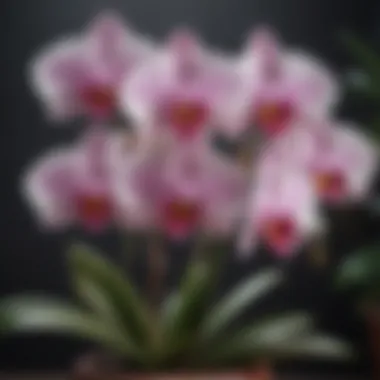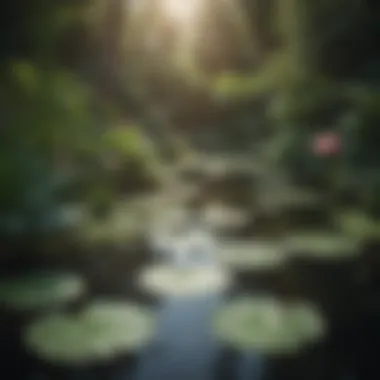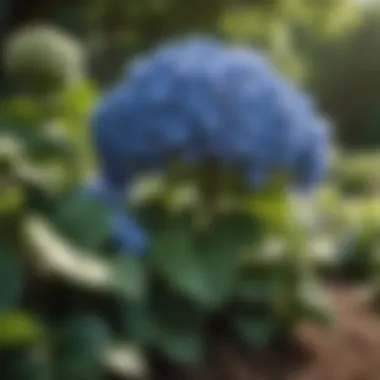Elevate Your Outdoor Space with the Best Flowers for Shade


Outdoor Decor Ideas
When it comes to elevating your outdoor space, selecting the best flowers for shaded areas is essential. The right floral choices can add a touch of elegance and color to your garden, even in the absence of direct sunlight. Seasonal inspirations play a significant role in determining the type of flowers that will thrive in shaded environments, ensuring your outdoor decor remains vibrant throughout the year. Furthermore, careful furniture selection can complement your choice of flowers, creating a harmonious and inviting atmosphere in your garden. Decorative lighting can enhance the beauty of your shaded flower beds, creating a magical ambiance during evenings and night-time. Thoughtful plant arrangements can maximize the visual impact of your flowers, showcasing their beauty in a well-coordinated manner. Additionally, hardscaping solutions such as pathways and garden structures can provide a backdrop for your shaded blooms, enhancing the overall aesthetic of your outdoor space. Sustainable practices, including environmentally-friendly gardening techniques, can further enhance the appeal of your garden, creating a space that is not only aesthetically pleasing but also eco-conscious.
Understanding Shade Gardening
For those venturing into the realm of gardening, understanding how shade impacts plant growth is imperative. Shade gardening involves cultivating plants that thrive in reduced sunlight conditions. Embracing this practice allows gardeners to transform dim areas into vibrant, lush spaces. By comprehending the nuances of shade, individuals can curate diverse plant selections tailored to specific light requirements. This knowledge amplifies the potential for creating enchanting outdoor environments, even in shaded settings.
Types of Shade
Full Shade
Full shade characterizes areas receiving minimal to no direct sunlight throughout the day. This shade type is ideal for plants that thrive in low-light environments, such as certain ferns and hostas. The key advantage of full shade is the preservation of plant coloration and the prevention of sunburn on delicate foliage. However, challenges may arise in promoting flowering in some full shade plants due to limited access to sunlight.
Partial Shade
Partially shaded areas receive a blend of sunlight and shade during the day. This versatile condition accommodates a wider range of plants, offering opportunities for both sun-loving and shade-tolerant species to flourish. Partial shade presents an excellent balance for plants that require some sunlight for energy production while benefiting from sheltered conditions at other times. Ensuring plant varieties suit this fluctuating light environment enhances overall garden diversity and resilience.
Dry Shade
Dry shade refers to areas where minimal moisture reaches the ground due to factors like tree canopies or obstructed drainage. Plants thriving in dry shade possess adaptations that enable them to endure low water availability. Species like barrenworts and English ivy excel in these conditions by conserving water and thriving in drier soil. Despite the challenges of limited water access, dry shade presents opportunities to cultivate plants resilient to arid conditions, adding a unique dimension to shaded garden spaces.
Dappled Shade
Dappled shade manifests as shifting patterns of light and shadow caused by filtered sunlight passing through overhead foliage. This transitional light environment creates dynamic growing conditions suited to a variety of plants. Dappled shade is beneficial for species that prefer intermittent sunlight, enhancing their growth and flowering patterns. The ever-changing play of light in dappled shade areas offers an enchanting backdrop, inviting the cultivation of diverse plant species that adapt beautifully to this captivating lighting interplay.
Factors to Consider
In the realm of shade gardening, understanding the various factors that come into play is essential to cultivate a thriving outdoor space. Factors define the success of a garden landscape, underlining the importance of meticulous planning and consideration. Soil Quality, Watering Needs, and Climate Considerations stand out as pivotal elements to contemplate. Each factor contributes uniquely to the vitality and sustainability of the plant life in shaded areas. Soil Quality serves as the foundation of any garden, determining the health and growth of plants. Watering Needs dictate the hydration levels crucial for plant survival, guiding gardeners on sustaining greenery without direct sunlight. Climate Considerations delve into the adaptability of plants to specific environmental conditions, ensuring the selection of flora resilient to shade. Delving into these factors equips garden enthusiasts with the knowledge needed to curate a picturesque and flourishing shaded garden.
Soil Quality
Acidic Soil
Acidic soil presents itself as a p H-balanced haven for shade-loving flora, enriching the soil with essential nutrients. The acidity level of the soil influences plant growth, enhancing the absorption of key minerals vital for plant development. In the context of this article, acidic soil emerges as a popular choice for shaded environments due to its ability to foster the growth of specific shade plants effectively. Its unique acidity profile creates an optimal environment for flora accustomed to subtler sunlight exposure, promoting lush foliage and robust blooms in shaded areas. Gardeners appreciate acidic soil for its capacity to support the flourishing of diverse plant species in environments with limited natural light, sparking an array of gardening possibilities. Although acidic soil offers numerous advantages for shaded gardens, proper maintenance and monitoring of the pH levels are imperative to ensure optimal plant health.
Well-Draining Soil
Well-draining soil plays a crucial role in mitigating waterlogged conditions that may hinder plant growth in shaded settings. Its key characteristic lies in facilitating effective drainage, preventing water stagnation that could jeopardize the root systems of shade plants. The significance of well-draining soil in this article stems from its capacity to maintain an ideal moisture balance, safeguarding plants from potential water-related stress. Its unique feature of promoting aeration within the soil contributes to the overall health of shade plants, allowing roots to access oxygen essential for robust growth. Moreover, well-draining soil proves advantageous for shaded gardens by preventing moisture-related issues such as root rot, thus fostering a conducive environment for plant longevity. Harnessing the benefits of well-draining soil in shaded areas ensures the vitality and sustainability of the garden ecosystem.


Watering Needs
Low Water Requirements
Low water requirements signify the ability of certain shade-loving plants to thrive in environments with minimal irrigation demands. The key characteristic of low water requirements lies in the plants' adaptability to survive on infrequent watering schedules, a favorable trait in shaded garden settings. In the context of this article, plants with low water needs emerge as a popular choice for enhancing shaded outdoor spaces due to their resilience to dry conditions. Their unique feature of conserving water efficiently positions them as sustainable options for individuals seeking low-maintenance greenery in shaded areas. Embracing plants with low water requirements in shaded gardens presents advantages, including reduced water consumption and ease of care, elevating the allure of shaded landscapes without compromising on plant health.
Moderate Watering
Moderate watering serves as a balancing act between excessive hydration and drought stress for shade plants, ensuring optimal moisture levels for healthy growth. The key characteristic of moderate watering lies in providing adequate hydration to plants without risk of waterlogging, promoting strong root development and vibrant foliage in shaded environments. In the context of this article, moderate watering stands out as a preferred choice for sustaining a diverse range of shade plants effectively. Its unique feature of striking a balance between moisture retention and drainage fosters the well-being of plants in shaded areas, promoting lush foliage and prolific blooms. Implementing a moderate watering regimen in shaded gardens offers advantages such as fostering robust plant growth and minimizing water-related issues, enhancing the visual appeal and resilience of shaded outdoor spaces.
Climate Considerations
Cool Shade Plants
Cool shade plants thrive in environments with lower light intensity, showcasing adaptability to shade conditions and cool temperatures. The key characteristic of cool shade plants lies in their ability to flourish in shaded areas, offering striking foliage and blooms without direct sunlight. In the context of this article, cool shade plants prove to be a beneficial choice for adding texture and color diversity to shaded gardens. Their unique feature of thriving in cooler climates enhances the visual interest of shaded outdoor spaces, creating a tranquil ambiance through their vibrant presence. Incorporating cool shade plants in garden designs presents advantages such as maintaining greenery in regions with limited sunlight exposure and infusing a refreshing aesthetic into shaded landscapes.
Tropical Shade Plants
Tropical shade plants embody lushness and vibrancy, adapting well to shaded environments reminiscent of their natural habitats. The key characteristic of tropical shade plants lies in their affinity for warm, humid conditions, thriving in shaded areas with a tropical ambiance. In the context of this article, tropical shade plants emerge as a favored choice for infusing exotic charm and rich colors into shaded outdoor spaces. Their unique feature of exuding a tropical allure enhances the visual appeal of shaded gardens, transporting individuals to lush, verdant paradises within their outdoor oases. Embracing tropical shade plants in garden compositions offers advantages such as evoking a sense of luxury and sophistication in shaded environments, elevating the ambiance and beauty of outdoor settings.
Top Flower Choices for Shade
Elevating your outdoor space with the best flowers for shade is crucial for creating a visually appealing garden that thrives in low light conditions. When considering top flower choices for shade, it is essential to prioritize species that can flourish without direct sunlight, adding pops of color and texture to the shaded areas of your garden. Selecting the right flowers for shade not only enhances the aesthetic appeal but also ensures that your garden remains vibrant and lively even in spots with minimal light exposure.
Colorful Blooms
When it comes to vibrant and colorful blooms that excel in shade, Begonias, Astilbes, and Lungworts are standout choices. These flowers not only bring a spectrum of hues to your garden but also offer unique characteristics that make them ideal for shaded areas.
Begonias
Begonias are renowned for their vibrant blooms and striking foliage, making them a popular choice for shade gardens. Their lush petals come in various shades, including vivid pinks, oranges, and reds, adding a burst of color to any shaded space. One key characteristic of Begonias is their ability to thrive in low light conditions, making them a resilient and versatile option for shaded areas. While Begonias require moderate watering and well-draining soil, their unique feature lies in their adaptability to varying light levels, ensuring steady growth and continuous blooming in shaded environments.
Astilbes
Astilbes are known for their feathery plumes of flowers that bloom in shades of pink, red, and white, creating a soft and elegant aesthetic in shade gardens. A key characteristic of Astilbes is their preference for moist, well-drained soil, making them ideal for areas with higher humidity levels. This unique feature allows Astilbes to thrive in shaded conditions where other plants may struggle, providing a beautiful and delicate touch to your garden.
Lungworts
Lungworts, also called Pulmonarias, are prized for their speckled leaves and dainty, tubular flowers that bloom in shades of blue, pink, and purple. One key characteristic of Lungworts is their ability to thrive in dappled shade, where sunlight filters through light foliage, creating a picturesque effect. Their unique feature lies in their tolerance for varying light conditions, making them adaptable and resilient in shaded environments.


Foliage Options
In addition to colorful blooms, foliage options like Ferns, Hostas, and Heucheras play a crucial role in enhancing the visual appeal of shade gardens. These plants offer a diversity of textures and shapes, adding depth and richness to shaded areas.
Ferns
Ferns are prized for their delicate fronds and lush greenery, bringing a touch of elegance to shade gardens. Their key characteristic lies in their ability to thrive in moist, well-drained soil, making them suitable for shaded areas with higher humidity levels. Ferns' unique feature is their ability to add a tropical vibe to shade gardens, creating a lush and vibrant atmosphere with minimal sunlight.
Hostas
Hostas are beloved for their large, textured leaves that come in various shades of green, blue, and gold, offering versatility and visual interest to shade gardens. A key characteristic of Hostas is their adaptability to different light levels, making them ideal for dappled shade or partial shade conditions. Their unique feature lies in their resilience to varying soil types and moisture levels, ensuring consistent growth and foliage vitality in shaded environments.
Heucheras
Heucheras, also known as Coral Bells, are prized for their colorful foliage in shades of purple, silver, and green, adding a vibrant touch to shade gardens. Their key characteristic is their adaptability to both full shade and partial shade conditions, making them a versatile choice for various shaded areas. The unique feature of Heucheras is their longevity, as they are perennial plants that thrive in shaded environments, providing year-round color and texture to your garden.
Perennials for Shade
Perennials like Bleeding Hearts, Coral Bells, and Foxgloves offer enduring beauty and charm to shade gardens, making them essential choices for creating a flourishing and sustainable outdoor space.
Bleeding Hearts
Bleeding Hearts are known for their heart-shaped flowers that bloom in shades of pink and white, adding a romantic and whimsical touch to shade gardens. A key characteristic of Bleeding Hearts is their preference for well-drained soil with moderate moisture, making them ideal for partial shade conditions. Their unique feature lies in their elegance and delicate appearance, creating a graceful ambiance in shaded areas.
Coral Bells
Coral Bells are prized for their bell-shaped flowers and vibrant foliage in shades of red, pink, and bronze, offering a splash of color to shade gardens. The key characteristic of Coral Bells is their adaptability to various light levels, making them suitable for different shaded environments. Their unique feature lies in their drought tolerance, allowing them to thrive in conditions with minimal watering while maintaining their vibrant foliage and blooms.
Foxgloves
Foxgloves are renowned for their spires of tubular flowers in shades of purple, pink, and white, bringing a vertical dimension to shade gardens. One key characteristic of Foxgloves is their preference for rich, well-drained soil, making them ideal for cool shade conditions. Their unique feature lies in their biennial nature, as they reseed easily and offer a continuous display of blooms in shaded areas.
Annuals for Shade
When incorporating annuals into shade gardens, species like Impatiens, Wishbone Flowers, and Torenia provide seasonal bursts of color and beauty, complementing the lush foliage and perennial blooms in shaded areas.
Impatiens
Impatiens are celebrated for their vibrant flowers in shades of pink, orange, and white, showcasing a spectrum of colors in shaded gardens. A key characteristic of Impatiens is their ability to thrive in low light conditions, making them well-suited for shaded areas with limited sunlight. Their unique feature lies in their rapid growth and prolific blooming, ensuring a continuous display of colorful flowers throughout the growing season in shaded environments.


Wishbone Flowers
Wishbone Flowers, also known as Torenia, are prized for their tubular blooms in shades of blue, purple, and white, adding a touch of whimsy to shade gardens. Their key characteristic is their preference for moist, well-drained soil, making them ideal for cool and humid shade conditions. The unique feature of Wishbone Flowers is their ability to attract pollinators, such as bees and butterflies, enhancing biodiversity in shaded areas while offering a charming and picturesque display.
Torenia
Torenia, commonly known as the Wishbone Flower, boasts vibrant trumpet-shaped blooms in shades of purple, blue, and white, adding a tropical flair to shaded gardens. A key characteristic of Torenia is its preference for moderate watering and well-drained soil, making it suitable for shaded areas with consistent moisture levels. The unique feature of Torenia lies in its versatility, as it can thrive in various light conditions, from cool shade to dappled shade, providing a continuous show of vibrant blooms throughout the gardening season.
Tips for Shade Gardening Success
Shade gardening is a delicate art that requires careful consideration and planning to achieve stunning results in darkened areas of your outdoor space. In this section, we delve into the essential tips that will serve as your guide to success in cultivating a flourishing shaded garden. Understanding the nuances of proper plant placement, watering needs, and soil quality is crucial for creating a thriving oasis in the shadows. By following these tips, you can transform a dim corner of your garden into a vibrant and inviting retreat, teeming with life and color.
A key element in shade gardening success is proper plant placement, which involves strategically positioning plants to optimize their exposure to light levels. Matching plants with specific light requirements is essential for ensuring their growth and blooming potential. By identifying the light conditions in different areas of your garden, you can select shade-loving plants that thrive in dimmer settings, enhancing the overall aesthetic appeal of your outdoor space.
Matching Plants with Light Levels
Matching plants with light levels is critical for their health and development. Different plant species have varying light requirements, ranging from full shade to partial shade. By carefully considering the light levels in your garden, you can select plants that are well-suited to thrive in specific conditions. Shade-tolerant plants such as ferns and hostas flourish in areas with limited sunlight, adding a touch of greenery and texture to shaded corners.
Grouping Plants with Similar Needs
Grouping plants with similar needs simplifies maintenance tasks and promotes harmonious growth patterns in your shaded garden. By clustering plants with comparable watering and soil requirements together, you create micro-environments that cater to their specific needs. This practice not only streamlines care routines but also fosters a balanced ecosystem within your garden, allowing plants to coexist and thrive in a shared environment. Grouping shade-loving plants with similar needs ensures efficient resource allocation and maximizes their overall potential in shaded settings.
Creating a Blissful Shade Garden
In the realm of gardening, the significance of creating a blissful shade garden cannot be overstated. As nature enthusiasts and gardening aficionados seek to curate outdoor sanctuaries that exude tranquility and natural beauty, the realm of shaded gardens provides a unique canvas for artistic expression. The allure of shade lies in its potential to evoke a sense of mystery and serenity, offering a respite from the harshness of direct sunlight. For those aiming to craft an outdoor space that exudes charm and sophistication, the careful curation of a shade garden presents a delightful opportunity.
Design Elements
Texture Variety
Texture variety stands as a cornerstone in the creation of a visually appealing and harmonious shade garden. The intricate interplay of different textures, ranging from the velvety softness of lamb's ear to the glossy sheen of magnolia leaves, adds depth and interest to the landscape. The juxtaposition of rough against smooth, coarse against delicate, creates a sensory experience that transcends the visual. This intermingling of textures not only captivates the eye but also invites tactile exploration, further enriching the sensory tapestry of the garden. Embracing texture variety in garden design allows for the creation of captivating vignettes and dynamic contrasts, ensuring that each corner holds a story waiting to be discovered.
Height Variations
Height variations in a shade garden contribute immensely to its overall aesthetics and functionality. By strategically incorporating plants of varying heights, from ground-hugging creepers to lofty ferns, gardeners can craft a layered masterpiece that captures the essence of a thriving ecosystem. Taller plants serve as focal points, drawing the gaze upward and instilling a sense of grandeur, while lower-growing specimens create a verdant carpet that anchors the space. The dynamic interplay of height not only enhances visual interest but also facilitates efficient space utilization, allowing for the cultivation of a diverse range of plant species within a limited area. Embracing height variations in garden design enables the creation of a multi-dimensional landscape that is as visually captivating as it is functionally efficient.
Maintenance Tips
Weed Control
Weed control stands as a fundamental aspect of maintaining the pristine beauty of a shade garden. Unwanted weeds not only detract from the visual appeal of the landscape but also compete with desirable plants for essential nutrients and resources. By implementing proactive weed control measures, such as mulching, hand weeding, and strategic plant placement, gardeners can safeguard the health and vitality of their shade garden. The meticulous eradication of weeds not only enhances the aesthetic charm of the garden but also fosters a conducive environment for the growth and flourishing of desired plant species, ensuring a harmonious botanical tapestry that thrives in the absence of invasive intruders.
Pruning Practices
Pruning practices play a pivotal role in shaping the form and vitality of plants within a shade garden. Regular pruning not only promotes the growth of healthy new shoots but also helps maintain the desired size and shape of ornamental shrubs and trees. By removing dead or diseased branches, gardeners can prevent the spread of ailments and enhance the overall appearance of the garden. Pruning also allows for the removal of overcrowded or crossing branches, improving airflow and sunlight penetration within the canopy. Through judicious pruning practices, gardeners can sculpt their shade garden into a harmonious tableau of verdant beauty, where every plant shines with vigor and vitality.







